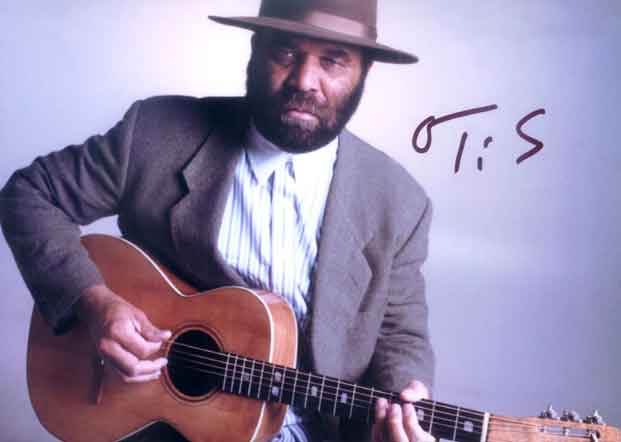Otis Taylor: Multi-dimensional, panoramic art, impossible to absorb in a single setting, demanding to be experienced, to be felt, first. From there, it only gets deeper...Otis Elevates
Being Of A Madness Most Discrete
By David McGee
PENTATONIC WARS AND LOVE SONGS
Otis Taylor
Telarc
Otis Taylor has had a distinguished career, dating back to his 1996 album debut, Blue Eyed Monster. In the years since, the Chicago native has accumulated both blues and jazz awards for his music, which is, all at once, rootsy and progressive, blues and jazz, lyrical and hard edged, deeply moral and morally ambiguous, romantic and realistic. Taylor's ambitious soundscapes and storyteller's aesthetic bring to mind mid-career Oscar Brown, Jr., before his militancy became unnervingly strident and all consuming, turning off some of his early supporters and costing him professionally, which did nothing to stop Brown from pursuing his vision. He composed probing, unflinching scenarios in which the characters were all tangled up in romantic and social conflicts both internal and external, and set them in a bristling, agitated blend of jazz, R&B and theater song, using the music as a complementary voice, a Greek chorus, to his own.
Otis Taylor has pursued a similar path, minus the theatrical aspirations of some of Brown's projects, while going his own way with a similar clear focus on his mission. Of late he's had some success landing songs on film soundtracks: "Nasty Letter" in 2007's underrated Shooter, with Mark Wahlberg; "Nasty Letter" and "Ten Million Slaves" both are featured in the new Michael Mann film, Public Enemies. Last year he made an indispensable contribution to roots music with the release of Recapturing the Banjo: The Black Banjo Project, an album length excursion into the African origins of the instrument, which he also presented live with guests Guy Davis, Corey Harris, Alvin Youngblood Hart and Don Vappie in supporting roles (see related YouTube clip below).
Otis Taylor and friends, 'Recapturing the Banjo'
Exploring the African roots of the banjo, an outgrowth of Taylor's 2008 album project.Pentatonic Wars and Love Songs returns him to the Afro-centric themes of some of his early albums such as When Negroes Walked the Earth (1997) and White African (2001) and features the strongest writing of his career, truly gripping tales centered on various desultory experiences of love, and that don't mean pie-in-the-sky. Taylor's characters invariably are at loose ends, yearning for something that's not going to happen ("Sunday Morning"), trying to find some equilibrium after being betrayed ("Young Girl Down the Street"), driven to murder in the name of love ("Dagger By My Side"), haunted by ghostly importunings to join a lover in the afterlife ("If You Hope"), trying to understand a mother's love after she's taken up with another woman and dumped her children's father ("Mama's Best Friend"). These are certainly love songs of a different stripe, but Taylor, who is on record as saying, "I may write love songs, but they aren't always going to be happy and pretty," is only being true to himself in looking askance at the emotion the immortal Bard, Shakespeare, described memorably as "a madness most discrete, a choking gall and a preserving sweet." Without going into a musicological discourse on the pentatonic scale, except to remind all that it is common in many musics, but especially in those styles Taylor works in, it may be useful to note that the phrase "pentatonic wars" emanates from Steven Spielberg's Close Encounters of the Third Kind. Remember the mother ship's tone sequence? Lancome, the character played by the great French film director Francois Truffaut, translated it as "It's the pentatonic war. That old musical controversy between the five- and seven-note scales." Other than his use of pentatonic scales herein, Taylor's purpose in employing this phrase as part of the album title may be purely whimsical or maybe he's suggesting that the encounters we have with his characters are of an otherworldy nature.
Cassie Taylor: A vocalist to be dealt withNow that's believable, because as straightforward as are his narratives, so is Taylor's music oblique and out there, but deceptively so. With Ron Miles playing winsome, searching cornet lines; Jason Moran punctuating the arrangements with brooding, Bill Evans-ish piano; cellos and violins (courtesy Valerie Levy Franzese and Chuck Hugenberg, respectively) adding sumptuous ache on four songs; Taylor himself alternating between howling, protesting interjections of electric blues guitar and moody, austere acoustic guitar; a most discrete, subtle rhythm section in drummer Nasheet Waits and bassists Cassie Taylor (his daughter, about whom more later) and Tarus Mateen; plus the exotic, ominous textures supplied Fara Tolno's odjembe drums, Taylor uses the soundscape to add heat, an aural evocation of his characters' conflicted inner lives, to contrast with his vocals, which, earthy and gritty though they be, simmer at low flame, by design. You sense this otherworldliness in the swirling, eerie flow behind his open-veined, metaphorical lament rooted in pain and a child's death, "Lost My Guitar"; you sense it in the ominous grind and stomp (enhanced by Brian Juan's soulful organ) fueling his character's bitter revelations about leaving his wife and taking up with a "Young Girl Down the Street." These essential atmospheric devices serve not only Taylor but notably his daughter Cassie, who emerges here as a vocalist to be dealt with. Her whispery, satiny voice carries exactly the right proportions of hope and hopelessness necessary to underscore her ambivalent expectation of a long-lost love returning soon to her bed in "Sunday Morning," a performance so haunting and heart wrenching it sets the tone and mood for the action to follow, hovering over this world like, well, a mother ship. Similarly, on "Mama's Best Friend," the song about the lesbian mom, her multitracked moaning and hushed revelations, along with her scatted lines, evoke a daughter's confusion even as the roiling, skittish, percussive music seconds her emotion. On "Maybe Yeah," as Nasheet Waits rolls out a military march figure on the snare, as Ron Miles's cornet lines float through the melody with an insouciant air, as Jason Moran adds evocative, hit-and-run piano filigree, Cassie turns up the sultry factor by about 10 without ever losing her cool, and loading a single word, "may-be," with an illegal dollop of sexual allure that isn't even diminished by the conditions for such an assignation: "a bag of diamonds, a box of pearls, a ruby comb—oh, baby, take me home!" Yes! You got it! Where do I sign up!?
So these pentatonic wars are loaded, freighted as it were, with backstory but are mere prelude to further unsettling dramas yet taking shape. This is Otis Taylor's multi-dimensional, panoramic art, impossible to absorb in a single setting, demanding to be experienced, to be felt, first. From there, it only gets deeper, as you explore the unity between narrative and instrumental dialogue, until you arrive at a place where the entity as a whole can only be regarded as some kind of masterpiece.
Otis Taylor, solo acoustic, live at Montreaux Jazz Festival, July 7, 2008
THE BLUEGRASS SPECIAL
Founder/Publisher/Editor: David McGee
Contributing Editors: Billy Altman, Laura Fissinger, Christopher Hill, Derk Richardson
Logo Design: John Mendelsohn (www.johnmendelsohn.com)
Website Design: Kieran McGee (www.kieranmcgee.com)
Staff Photographers: Audrey Harrod (Louisville, KY; www.flickr.com/audreyharrod), Alicia Zappier (New York)
E-mail: thebluegrassspecial@gmail.com
Mailing Address: David McGee, 201 W. 85 St.—5B, New York, NY 10024
Founder/Publisher/Editor: David McGee
Contributing Editors: Billy Altman, Laura Fissinger, Christopher Hill, Derk Richardson
Logo Design: John Mendelsohn (www.johnmendelsohn.com)
Website Design: Kieran McGee (www.kieranmcgee.com)
Staff Photographers: Audrey Harrod (Louisville, KY; www.flickr.com/audreyharrod), Alicia Zappier (New York)
E-mail: thebluegrassspecial@gmail.com
Mailing Address: David McGee, 201 W. 85 St.—5B, New York, NY 10024



